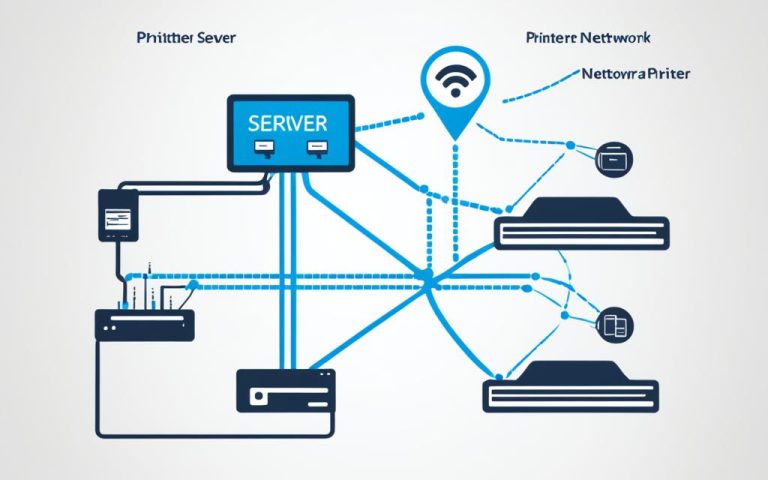A home network connects devices to a single network, making it easy to talk to all devices at once. It lets you set up security for all devices from one spot. Home networks use both private and public IP addresses for internet access.
Key Takeaways:
- When setting up a home network, it is important to consider the node requirements and best practices for optimal performance.
- The number of devices that can connect directly to the Homey Pro 2019 and earlier is 15 devices, while the Homey Pro 2023 can support 32 or 64 devices directly1.
- A router device can typically connect to approximately 10 devices, with a reach of 5 meters indoors and 10 to 15 meters outdoors1.
- Theoretical calculations indicate that a Homey Pro 2019 setup can handle up to 166 devices, while a Homey Pro 2023 setup can support up to 705 devices1.
- Zigbee, the chip in Homey devices, can handle up to 20 devices, and Zigbee supports up to 65,536 different devices on a single network1.
- Wired networks are known to be more reliable and secure than wireless networks2.
- The estimated cost of installing network wiring can range from $500 to $1000 for a small office building and $2000 to $6000 for a large office building2.
- Network components, such as Cat5, Cat5e, Cat6, Cat7, and fiber optic cables, have varying capacities, costs, and speeds2.
- Consideration should be given to a multi-gig router with a 2.5GbE WAN port and 1 or more 2.5GbE LAN ports for a 4000 sq ft, 2 floor home with a 2 gig fiber internet connection3.
- Wireless Mesh networks with a wired backhaul, such as the Deco X75 Pro or Deco X55 Pro setups, can provide improved coverage and performance3.
Please do not forget to put the
How a Home Network Setup Works
Setting up a home network gives you two main choices: wired or wireless. Both need key items like a modem, router, Ethernet cables, and access points for good connectivity at home.
First, let’s explore wired networks. The modem connects to the internet, sending and receiving data from your internet service provider (ISP). Then, the router links to the modem, making a local area network (LAN) in your home. This lets many devices connect and share resources.
Wired networks use Ethernet cables, hubs, and switches for device connections. Cables like Cat5e and Cat6e support speeds up to 1 Gbps over 100 meters4. They offer stable and reliable connections, perfect for tasks needing fast internet speeds45.
Wireless networks, on the other hand, use Wi-Fi to connect devices without cables. Wi-Fi routers let devices join the network and get online wirelessly. But, wireless networks usually have slower speeds, around a few hundred Mbps per second4. Distance, interference, and device numbers can affect wireless performance.
To improve wireless network range, use access points or mesh systems. Access points boost Wi-Fi signals in poor coverage areas. Mesh systems use nodes to create a strong, unified Wi-Fi network at home4. These nodes ensure consistent coverage, overcoming obstacles and reducing dead spots.
Choosing between wired or wireless depends on your devices’ needs, your home’s layout, and how you use the internet. Mixing wired and wireless can give you the best of both worlds for your network setup.
How to Set Up a Home Network
Setting up a home network connects your devices and makes communication smooth. You can choose between a wired network or a wireless network. These steps will guide you to a reliable and efficient network at home.
1. Install the Router in a Central Location
Begin by placing your router in a central spot in your home. This ensures the Wi-Fi signal spreads evenly, reducing dead zones. Walls and furniture can weaken the signal, so put your router high and open for the best results.
2. Configure Security Settings
Protecting your network is key to keeping your data safe. Use Wi-Fi encryption like WPA2 or WPA3 and set a strong password to block unauthorized access. Update your router’s firmware often to fix security issues.
3. Wired Connections: Ethernet Cables and Switches
For a wired network, use Ethernet cables to link devices to the router. Cables like Cat5e and Cat6e support speeds from 1000 Mbps to 1 Gbps, ensuring quick and stable data transfer. Use Ethernet switches to add more ports for connecting devices.
4. Wireless Connections: Access Points
For a wireless network, add access points to your router to boost coverage. Place them where they won’t be blocked and are close to where people use the internet. This creates a strong network in big homes.
5. Additional Tips and Tricks
Here are some tips to improve your network setup:
- Check each device’s signal strength with the app for a strong mesh network6.
- Test speeds in different spots to find the best Wi-Fi and identify dead zones6.
- If speeds are slow, think about getting a faster internet plan or updating your modem6.
- Turn off Wi-Fi on your modem if it doubles as a router to stop interference6.
- Adjust your mesh router’s channel settings to dodge Wi-Fi interference from neighbors6.
- Keep your mesh system’s firmware updated and watch for new updates to boost performance6.
Follow these steps and use the best practices for a smooth and efficient home network. Enjoy seamless connectivity for all your devices.
Wired vs. Wireless Home Network Setup
Setting up a home network gives you the choice between wired or wireless connections. Each has its own pros and cons. Let’s look at the differences to help you decide for your home network setup.
Wired Networks: Stability and Speed
A wired network is great for certain situations. It’s more stable and reliable7, which is key for gaming, streaming, and big file transfers. It’s also faster than wireless networks, especially in places with lots of interference7.
Wired networks are more secure too. You can’t connect to them without using an Ethernet cable. This makes it harder for hackers to get into your network.
Wired networks also last longer than wireless ones. This means you might not have to replace your equipment as often. But, adding more devices to a wired network can be costly due to the need for more cables.
Wireless Networks: Convenience and Flexibility
Wireless networks have their own perks for home network setups. They’re easy to set up and expand. Adding new devices is simple without the need for cables. This makes them great for changing needs over time.
Wireless networks offer more freedom and ease of use. You can connect devices from anywhere in your home without cables. This is why they’re popular in homes with many devices and people.
But, wireless networks can be less secure than wired ones. Without the right encryption, signals can be intercepted. It’s crucial to use strong security measures to protect your network.
Wireless networks can also be less reliable due to interference and physical barriers. This can lead to slower speeds and weaker signals. For large homes, a mesh Wi-Fi system with multiple nodes can help ensure good coverage everywhere.
Some people choose a mix of wired and wireless networks. This hybrid approach offers flexibility and customization based on your needs and preferences.
In conclusion, picking between a wired or wireless network depends on what you need most. If you value stability, speed, and security, go for wired. For convenience, mobility, and flexibility, wireless might be the better choice. The decision should match your specific situation and goals.
Extend Home Network Range
Setting up a home network means making sure the Wi-Fi signal reaches every corner of your house. Both wired and wireless networks have limits, but there are ways to make your network go further. You can use different techniques and devices to boost your network’s reach.
Using Ethernet cables is a good way to improve coverage. These cables let you connect devices far from your Wi-Fi signal. But remember, Ethernet cables can only go up to 100 meters long8.
Wireless solutions can also help extend your network. Access points or Wi-Fi repeaters are great for this. They boost the Wi-Fi signal, so it reaches farther from your router. These devices rebroadcast the router’s signal, making it stronger in areas without cables8.
Mesh systems are also popular for better coverage. They use many access points to create a strong network. This means you get consistent performance everywhere in your home9. Mesh systems are easy to find and cover a big area with strong Wi-Fi9.
When picking a way to extend your network, think about a few things. The frequency band you use affects signal strength and interference. The 5 GHz band is faster and stronger than 2.4 GHz9. Routers that work on both 5.0 GHz and 2.4 GHz let you pick the best band for your devices9.
Choosing a modern router with the latest tech can really boost your network. Going for Wi-Fi 6 or 802.11ac routers can make your Wi-Fi stronger, handle more devices, and add security9. Some routers even have cool features like beamforming for better signal strength9.
Comparison of Network Extension Methods
| Method | Advantages | Disadvantages |
|---|---|---|
| Ethernet Cables | Provides stable and reliable connections | Requires physical cable installation which may be challenging in certain environments8 |
| Wi-Fi Repeaters | Wirelessly extends the network range8 | Signal may be weaker compared to the main router, reducing overall network performance8 |
| Mesh Systems | Provides seamless coverage and consistent performance9 | Can be more expensive compared to other solutions |
When looking at ways to extend your network, think about what you need and your budget. Whether it’s cables, repeaters, or mesh systems, making your network reach further means reliable internet everywhere in your home.
Home Network Security Tips
Keeping your home network safe is key in today’s connected world. By using the right steps, you can protect your devices and data. Here are some tips to boost your home network security:
Create VLANs for Privacy and Reduced Congestion
VLANs let you divide your network into separate parts. This keeps devices apart and reduces network slowdowns. By grouping devices by their use, like work or IoT, you lower the chance of unauthorized access. Adding VLANs can make your network safer10.
Use a VPN on Your Router for Enhanced Encryption and Privacy
A VPN encrypts your internet traffic and hides your IP address. Putting a VPN on your router secures all devices on your network. Even if a device’s security is weak, the VPN keeps hackers out and protects your data. A VPN for routers is a great way to keep your network safe and private online10.
Protect Against Malware and Hackers
Malware and hackers are big threats to your network. Here’s how to fight them:
- Update your devices and software regularly to fix security issues.
- Use strong, unique passwords for everything. Don’t reuse them.
- Turn on two-factor authentication (2FA) when you can. This adds an extra step to log in.
These steps help keep your network safe from threats and unauthorized access11.
Secure Your Router
Your router connects your devices to the internet, making it a target for hackers. Here’s how to make it safer:
- Change your router’s admin username and password to something strong.
- Turn off remote management to stop unauthorized access.
- Update your router’s firmware regularly for better security.
- Use routers with DDWRT firmware for more security features. This improves your network’s safety10.
Securing your router makes your whole network safer, protecting all your devices10.
Practice Device Isolation and Privacy
Keeping devices separate in your network is key for privacy and security. Here’s what to do:
- Avoid sharing files or connections unless you must.
- Use secure ways to share files, like encrypted cloud storage.
- Turn devices off when not in use or when you’re away.
These steps lower the risk of unauthorized access and keep your network safe10.
By following these home network security tips, you can protect your devices and network. Keeping your network secure is crucial in today’s digital world10.
Place Your Router in a Central Position
Router placement is key to a strong Wi-Fi signal in your home. By placing your router in the right spot, you can improve coverage and reduce interference. This makes your network more reliable.
For homes under 1,500 square feet, one router is usually enough12. But for better speed and coverage, think about getting a Wi-Fi 6 (802.11ax) router12.
In bigger homes or those with multiple floors, mesh networks are a good idea1213. These networks use several nodes to ensure Wi-Fi is strong everywhere1213. Adding nodes in weak spots can fix signal issues13.
Whether you have one router or a mesh network, where you put the main router matters1213. For the best coverage, put your router in the middle of your home1213.
Putting your router up high helps spread the signal further. Since signals go down, placing it high is best12. Keep it away from other devices and metal objects to avoid signal loss12.
Adjusting your router’s antennas can also improve signal direction12. Try different positions to get the best signal strength and coverage12.
Use tools like NetSpot to map your Wi-Fi signal and find weak spots12. This lets you adjust your router’s position for better coverage12.
Consider a Mesh Unit
If you’re having trouble with Wi-Fi dead zones at home, it’s time to look into a mesh unit. These devices are made to connect to your router and spread out a strong signal everywhere in your home.
Unlike regular routers or Wi-Fi boosters, mesh units use many devices together to make one strong network. This means your devices will always connect to the strongest signal, giving you better performance and a steady connection.
Mesh Wi-Fi systems usually come in packs of two or three, making it easy to get better coverage14. Many have gotten great reviews, like the Asus ZenWiFi AX (XT8) and the Netgear Orbi RBKE963 WiFi 6E Mesh System, both scoring 4.514. The Eero 6+ and TP-Link Deco W7200 Mesh Wi-Fi 6 System also got high marks, at 4.014.
Mesh Wi-Fi has become very popular for getting rid of dead zones and giving you solid coverage at home15. It’s especially good for big homes or places with many floors, where one router can’t keep up.
Traditional Wi-Fi boosters can make many networks, which can slow down your internet and cause problems15. But mesh systems offer a better solution that grows with your needs without losing speed.
Setting up mesh units is easy and you can place them around your home. Many come as three-piece kits, which is a common setup for homes16. These systems can have one router and up to nine satellites, showing how you can expand your network16.
Where you put mesh units is key for the best performance. They should be close to each other, about 30-50 feet apart, for the best signal16. Using Ethernet for backhaul is also a good idea to keep speeds high between units16.
| Mesh System | Rating |
|---|---|
| Asus ZenWiFi AX (XT8) | 4.5 |
| Netgear Orbi RBKE963 WiFi 6E Mesh System | 4.5 |
| Eero 6+ | 4.0 |
| TP-Link Deco W7200 Mesh Wi-Fi 6 System | 4.0 |
| Google Nest Wifi | 4.0 |
| Vilo Mesh Wi-Fi System | 3.5 |
| TP-Link Deco X20 AX1800 Whole Home Mesh Wi-Fi 6 System | 3.5 |
Getting a mesh unit can really boost your home network’s reach and give you a strong signal everywhere. It’s great for big homes, multi-story buildings, or just getting rid of Wi-Fi dead zones. Consider a mesh unit to make sure your devices work well everywhere.
Ethernet: The Best Home Network Is Wired
In today’s world, having a fast and reliable internet connection is key. Ethernet is the top choice for a stable and secure home network. It’s better than wireless networks.
Ethernet is reliable and fast. It connects devices directly, cutting down on interference and boosting speed. It’s perfect for gamers, movie lovers, or anyone working from home. Ethernet means no lag or dropped connections.
For activities like gaming and streaming in high definition, Ethernet is the best. Say goodbye to buffering and hello to smooth streaming. You can dive into your favorite games and shows without any trouble.
Ethernet also helps with mesh WiFi systems. It frees up wireless bandwidth for up to 200+ devices17. This means your network can handle many devices at once without slowing down.
To set up your wired network, you’ll need a network switch. This lets you add more devices to your network. Network switches are affordable, costing between $10 and $10018.
Modern WiFi systems like the NETGEAR Orbi support Ethernet cables. This improves connectivity and gets rid of dead spots17. You can extend your network and enjoy a strong connection everywhere in your home.
Setting up Ethernet is easy and lets you use your devices fully. It’s supported by devices like the NETGEAR Orbi, making it a great choice17.
While setting up a wired network can cost between $2,500 and $4,50018, it’s worth it. Ethernet offers stability, reliability, and fast performance for your home network.
Benefits of a Wired Network:
- Reliability: Ethernet gives you a stable and secure connection, cutting down on interruptions.
- Speed: It offers fast data transfer rates, perfect for heavy activities like gaming and streaming.
- Security: Wired networks are safer from hacking and interference than wireless ones.
- Scalability: You can easily add more devices to your network with network switches.
Choosing Ethernet means you get the best internet connection for speed and reliability. Don’t settle for less than a wired network.
| Component | Average Cost |
|---|---|
| Network plates and plugs | $10 – $2518 |
| RJ45 jacks | $10 – $2518 |
| Network switch | $10 – $10018 |
| Modems | $50 – $10018 |
| Routers | $80 – $12018 |
Investing in a wired network might cost more upfront, but it’s worth it for the long-term benefits. Switch to Ethernet and see how your home network can improve.
Conclusion
Creating a top-notch home network means paying attention to several key factors. By using best practices and solid network setup methods, you can make sure your network is safe and works well.
It’s important to know how different network devices work together. For instance, switches are vital for keeping connections strong and stable. Managed switches give you more control over things like how data moves and which channels get priority [19]. Routers help move data around and can also act as firewalls to keep your network safe [19].
For a reliable network, focus on using real switches for tasks like IGMP snooping and testing features like VSS or Stackwise [20]. Also, having a central console server to manage many devices at once can make network management easier [20].
Don’t forget about network security. Use firewalls and stick to practices like whitelists or blacklists to control data packets [19]. By following these tips and keeping up with the latest advice, you can build a secure, stable, and efficient home network.
FAQ
What is a home network setup?
A home network setup connects devices together. It lets you talk to all your devices at once. You can also manage security for all devices from one spot.
How does a home network setup work?
Home networks can be wired or wireless. You need a modem for internet access and a router for a local network. Use Ethernet cables for wired links and access points for Wi-Fi.
How do I set up a home network?
Start by placing the router in a central spot. Set up security options and add access points if needed. For wired links, use Ethernet cables and switches. For wireless, connect devices to the router.
What are the differences between a wired and wireless home network setup?
Wired networks offer fast speeds and are more secure. They’re great for big file transfers and gaming. Wireless networks let you connect more devices easily but might be slower and less secure.
How can I extend the range of my home network?
Extend your network with Ethernet cables, wireless repeaters, or a mesh system. These methods help cover more areas of your home.
What are some home network security tips?
Improve security by using VLANs for privacy and a VPN for encryption. These steps help protect against malware and hackers.
Where should I place my router for the best Wi-Fi signal?
Put your router in a central spot for the best Wi-Fi. Avoid hiding it and place it high up. Keep it away from windows to prevent signal loss.
What is a mesh unit, and how can it help extend my network coverage?
A mesh unit boosts your Wi-Fi signal over a larger area. It uses nodes to create a network that covers your whole home, ensuring strong signals everywhere.
Why is Ethernet the best option for a home network?
Ethernet offers a reliable and secure connection. It’s great for devices like TVs and computers. Use a network switch to connect more devices securely.
How can I build an optimized home network setup?
For an optimized network, think about node needs, wired or wireless setup, range extension, and security. Pick the best setup for your needs and focus on reliability and security.
Source Links
- https://community.homey.app/t/how-to-plan-and-setup-your-zigbee-network/94770 – [HOW TO] Plan and setup your Zigbee network
- https://thenetworkinstallers.com/blog/network-installation/ – Network Installation & Configuration: The Ultimate Guide
- https://community.tp-link.com/us/home/forum/topic/643484 – Help with Home Network Design
- https://nordvpn.com/blog/setup-home-network/ – How to set up a home network: An in-depth guide
- https://www.techtarget.com/searchnetworking/tip/Tips-for-setting-up-a-home-network – How to set up a home network — a 7-step guide | TechTarget
- https://www.cnet.com/home/internet/mesh-router-placement-tricks-to-boost-your-home-internet-speeds/ – Mesh Router Placement Tricks to Boost Your Home Internet Speeds
- https://www.matrix-ndi.com/resources/wired-vs-wireless-internet – Wired vs. Wireless Network: Which is Better?
- https://beambox.com/townsquare/extend-wifi-ethernet-or-wifi-marketing – Extend WiFi Ethernet | WiFi Marketing | Beambox
- https://www.netspotapp.com/wifi-troubleshooting/how-to-extend-wifi-range.html – How to Extend WiFi Range to Resolve a Weak Signal
- https://handbook.gitlab.com/handbook/security/network-isolation/ – Isolating your work notebook from other devices in your home network
- https://www.lenovo.com/us/en/glossary/secure-network/ – What is a Secure Network? How to Secure Your Wireless Network
- https://www.cnet.com/home/internet/wi-fi-tips-to-boost-your-internet-connection/ – Boost Your Wi-Fi and Stream Smoother, Not Slower With Your Internet Connection
- https://www.hcc.net/2020/02/the-best-location-for-your-router-for-actually-good-wi-fi/ – Tips for Optimizing Your WiFi Signal
- https://www.pcmag.com/how-to/how-to-set-up-a-wi-fi-mesh-network – No More Dead Zones! How to Set Up a Wi-Fi Mesh Network
- https://www.astound.com/learn/internet/how-to-set-up-mesh-wifi-network/ – How to set up a mesh WiFi network
- https://www.highspeedinternet.com/resources/how-to-set-up-mesh-network – How to Set Up a Mesh Network
- https://www.netgear.com/au/hub/wifi/mesh/ethernet-cable-mesh-wifi/ – Can I Use Ethernet with Mesh WiFi? | NETGEAR AU
- https://www.fixr.com/costs/hardwired-computer-network – Network Cable Installation Pricing | Internet Set Up Cost | Fixr
- https://blog.netwrix.com/2019/01/08/network-devices-explained/ – Network Devices: Types, Functions and Best Practices for Security Management
- https://networklessons.com/miscellaneous/how-to-build-a-network-home-lab – How to build a Network Home Lab



















